|
|
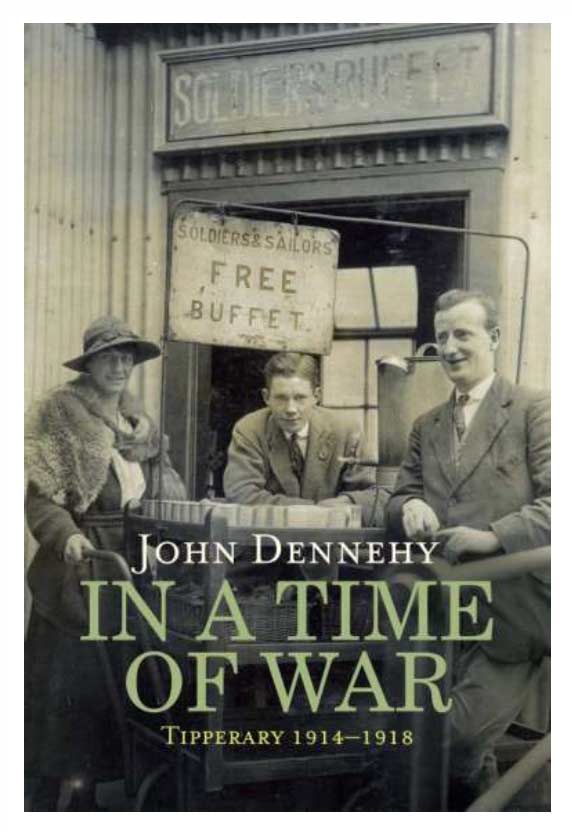 A new book by author John Dennehy will be officially launched in Thurles Library, situated in The Source building, Cathedral Street, on Thursday next, June 20th 2013, at 7.00pm. A new book by author John Dennehy will be officially launched in Thurles Library, situated in The Source building, Cathedral Street, on Thursday next, June 20th 2013, at 7.00pm.
Guest speaker for this event will be Mr Denis Marnane.
In this captivating new history book, entitled “In A Time Of War,” (1914 – 1918,) Tipperary native John Dennehy explores in great detail the profound political, economic, military and social impact of the Great War on just one Irish county; his own County Tipperary.
Little has been written about the impact of World War I on everyday life – food prices, the role played of women, soldier suicide, foreign refugees, etc.
It was a time of contested loyalties at home and unparalleled brutality abroad, and while the ordinary citizens were well aware of the bloody toll, thousands still continued to enlist. With the men now moved to fight, the women were mobilized to assist, playing a central role in all aspects of the home front from fund-raising to training in first-aid, yet all contributing to the emergence of women’s freedoms in Ireland after the war.
Yet, the insensitive handling of recruitment and the aborted attempt to impose conscription thus ensured there would be no successful transition from war to peace and Tipperary emerged radicalised and divided from this conflict.
The dramatic general election of December 1918 and the battle for independence that followed, muffled the trauma and emotion Tipperary experienced during World War I and set the scene for the political convulsions that would follow.
This is the story of that time – a microcosm for the impact of the Great War on Irish society as a whole. A truly excellent & factual read.
About The Author:
John Dennehy is a journalist from Clonmel, Co. Tipperary. He gained his PhD in history at University College Cork and has contributed to several publications on the subject of Tipperary during the First World War.
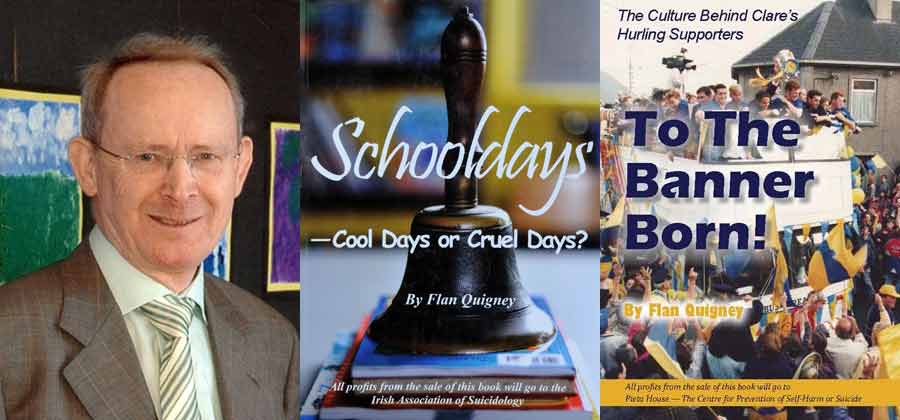
Here at Thurles.Info we get regular requests, mainly from elderly Irish people living & working abroad, asking for details of publications containing stories, anecdotes etc. which would remind them of home & past memories. Two such books have appeared in recent months, both of which make for most enjoyable holiday reading and both of which come from the imaginative pen of Co. Clare native & now retired Thurles school teacher, Mr Flan Quigney.
SCHOOLDAYS – Cool days or cruel days? By Flan Quigney
“Schooldays- Cool days or cruel days?” is a snapshot of what primary school life was like, to some degree, for the average child in 19th century Ireland but, to a greater extent, during the 20th century and up to the present day. This account takes us on a journey from the Hedge Schools to the Information Age of 2011.
To assist him along the way the author, a retired primary school teacher and former school principal, elicited the school-day experiences of 23 people ( and a group of 6th class boys ) ranging in age from 11 to 85. These enthusiastic, willing and supportive people shared their many thoughts and experiences on such topics as clothes, hairstyles, footwear, playground games, fights, corporal punishment, songs, funny incidents, sweets, past-times outside school, Confirmation, First Communion, Primary Cert, illnesses, cures, homework, myths and superstitions of childhood and much more.
This book is a chance to relive all those encounters of one’s school-days once again and to form your own opinion on that well worn adage, Aoibhinn Beatha an Scolaire. (Translation from Irish; “The scholar loves life.”)
TO THE BANNER BORN! By Flan Quigney
This publication is a sociological study of a cross-section of the Banner County’s passionate followers – the type who would go to see fifteen Clare jerseys hanging on a clothesline. It explores their experiences of encountering different kinds of supporters; of memorable games and venues; of banter, humour and the hunt for, and location of tickets.
“To the Banner Born,” examines modes of transport to matches from walking, cycling, thumbing, driving by pony and trap, travelling by boat, truck, car, bus, train, helicopter and aeroplane. It unveils anecdotes pertaining to hostelries, food, team colours, betting, slogans, songs, music and match day routines. Furthermore, the book charts Co Clare’s greatest triumphs, disappointments and injustices as seen by the fans.
To commemorate the Centenary of the founding of the GAA, RTE broadcast a documentary in 1984 entitled ‘Sunday after Sunday.’ In an hour-long programme, the Clare jersey was visible for about ten seconds. The programme was dominated by action involving the small group of very successful counties. Between senior, junior, intermediate, minor, under-21 and senior club, Clare had won just eight Munster titles and two All-Irelands between 1884 and 1984, most before RTE were established.
However, in the intervening twenty-seven years to 2011, ‘The Banner,’ have won seventeen Munster titles and eight All-Irelands. Sufficient reason for the loyal sons and daughters of Dál gCais to once more keep the bodhrán beating, the spirits raised and the throats cleared for “The Banner Roar,” and “The Clare Shout.”
All profits from the sale of both books go to Pieta House – The Centre for Prevention of Self- Harm or Suicide & The Irish Association of Suicidology. Copies are available in Ennis Bookshop, The Bookworm (Thurles), at Eason’s branches in Thurles, Nenagh and Clonmel, Co Tipperary.
Of course a limited edition only of signed copies by the author can be had direct from flanquigney@yahoo.ie .
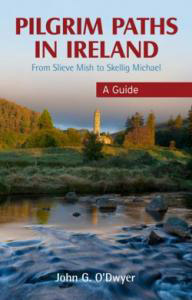 The latest publication, penned by the hand of Thurles native John G. O’Dwyer, entitled Pilgrim Paths In Ireland, is not just a mere guide book aimed at identifying Ireland’s ancient pilgrim paths. Instead each journey described, paints in words an entertaining narrative in itself, with the author setting out deliberately to carefully recount, in very much detail, his own personal experiences and feelings, as he completes each individual pilgrim route. The latest publication, penned by the hand of Thurles native John G. O’Dwyer, entitled Pilgrim Paths In Ireland, is not just a mere guide book aimed at identifying Ireland’s ancient pilgrim paths. Instead each journey described, paints in words an entertaining narrative in itself, with the author setting out deliberately to carefully recount, in very much detail, his own personal experiences and feelings, as he completes each individual pilgrim route.
This is one publication that is going to be quickly ‘snapped up,’ by organisations, clubs & societies, anxious to raise charitable funding for developmental & other worthwhile project work & all seeking new and inventive ways to raise their much needed future funding & sponsorship.
A founding member of Mid-Tipp Hill Walkers, John G. O’Dwyer is a Thurles based author, Travel Consultant and Tourism Studies teacher, who has spent a quarter century leading, not just large groups through the Irish scenic uplands, but also mountain climbing groups in the UK, Europe and Africa.
Himself a keen hill walker and rock-climber, John consequently has a passion & a magnificent depth of understanding of Ireland’s wild and beautiful upland terrains. Since 2012, he has walked every step of the ancient pilgrim trails of Ireland from Slemish Mountain in the North-east, where many believe Christianity in Ireland had its primary dawning, to the tiny Skellig Michael Island, where in medieval times the known world ended.
This experience has enabled John to produce a comprehensive, readable and thoroughly entertaining guide to Ireland’s mystical trails, all suitable for pilgrims, walkers, history lovers or those merely seeking an informative and entertaining read.
In his book, each route completed is described in minute detail, with directions as to the starting point, an estimate of the degree of difficulty, the likely time needed for completion, along with appropriate maps and warning alerts regarding any special problems that may be encountered en-route.
John also details, with some humour, the many fascinating and insightful characters he encounters along the way, from poets to pilgrims and peacemakers to pleasure seekers. Twenty first century Ireland has in many ways rejected the practice of formal religion, yet on the pilgrim trails of Ireland O’Dwyer discovered “a restless search for spiritual fulfilment that continues to reverberate into the 21st century.”
“Pilgrim Paths In Ireland,” is a first attempt to recount Ireland’s pilgrim paths and contains much to interest pilgrims, environmentalists, historians, those planning an Irish visit, along with casual readers seeking an informative, entertaining and humorous read.
John will launch his book at the Watermill, on Slievenamon Road, Thurles, on Wednesday 27th March at 8.30pm.
Nice opportunity to get an autographed copy of a truly enjoyable publication.
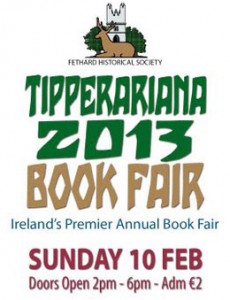 Tipperary will host the 18th Tipperariana 2013 Book Fair, Ireland’s premier annual fair, in The Fethard Ballroom, Fethard, Co Tipperary on Sunday next February 10th. Tipperary will host the 18th Tipperariana 2013 Book Fair, Ireland’s premier annual fair, in The Fethard Ballroom, Fethard, Co Tipperary on Sunday next February 10th.
This event, which is hosted annually by Fethard Historical Society, begins in the afternoon and will run from 2.00pm until 6.00pm.
Entry fee to visitors is just €2.00 and this year’s Fair boasts over thirty book dealers from all over Ireland, all anxious to both buy and sell.
As usual there will be a Café in full operation and a piano player will be on hand to serenade all visitors during the course of the afternoon.
So if you happen to have a loose copy of “Wuthering Heights” for sale, just lying around currently gathering dust and preferably personally signed by Emily Jane Brontë herself, then Fethard, Co. Tipperary is most definitely the place to be on Sunday afternoon next.
If you are buying, there are plenty of bargains also, in fact I got a copy of the hard to find “The Felons Track,” written by Michael Doheny (Latter a member of the Young Ireland movement.) at last year’s Tipperariana fair.
Julia Kavanagh (Born this day, 7th January 1824 – Died 28th October 1877) was an Irish Novelist & Biographer, born in Thurles, Co Tipperary, the only child to parents, Dublin born Morgan, Peter (Latter his Confirmation Name) Kavanagh (Irish author, poet, and novelist 1800 – 1874) and Bridget (née Fitzpatrick, latter who died 1888).
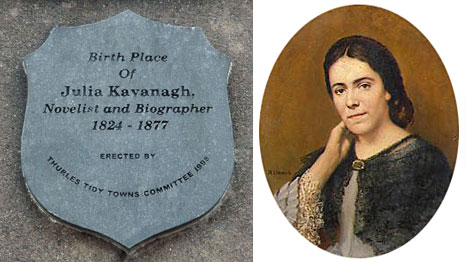 Her once small house sadly no longer exists, but stood at what is today the entrance to the Presentation Convent Secondary School, close to the junction leading from Cathedral Street into Mitchel Street, here in Thurles, Co. Tipperary. Her once small house sadly no longer exists, but stood at what is today the entrance to the Presentation Convent Secondary School, close to the junction leading from Cathedral Street into Mitchel Street, here in Thurles, Co. Tipperary.
An Irish Catholic, life for the young Miss Kavanagh was hard. She was partially crippled from youth (curvature of the spine), nevertheless she, through her own genius and strong connections, would carve out a successful career as a novelist, biographer and travel writer.
Her parents were married in 1823 and moved with Julia from Thurles to London, her father possibly as a teacher of languages. In late 1825 or early 1826 they moved to Paris, before returning to London again in 1837. When they returned to London, over the next year Morgan arranged for Julia to receive special treatment for her spinal problem. They returned to Paris in 1839 and stayed there until the early 1840s. It was during this early life with her parents in Paris, that Julia conquered her initial mastery of the French language and her remarkable insight into French modes of thinking, which was then perfected by her later long residences in Paris, Rouen and Nice.
Morgan was alone when he lived at 28 Dean Street, London in the early 1850s. Julia and her mother had parted from Morgan around 1846 and neither Julia or her mother are listed in the 1851 census for that address.
It was at this same address (28 Dean Street, Soho) that her father would become landlord & sub-lets two rooms to atheist Karl Marx, in Dec. 1850. This same address would also be the location at which Marx would write ‘Das Kapital,’ (1867) with the assistance of fellow revolutionary socialist Friedrich Engels. It was to here also that Friedrich Engels would send postal orders for £1 or £5 notes, each cut in half and sealed in separate envelopes, to avoid postal theft and in order that the impoverished and resident Marx family could pay their rent and continue to survive.
Note: Today, 26-29 Dean Street Soho, London, houses the famous restaurant “Quo Vadis,” (Latin: “Where are you going?”).
Julia now began to support herself and her invalid mother Bridget, with her writing career. Her first book was entitled “The Three Paths (1847), a story for the young, however her first work to attract the attention of her large readership was “Madeleine, a Tale of Auvergne,” (1848), a story of “heroic charity and living faith founded on fact.”
Her other works included; “Woman in France during the 18th Century,” (1850), “Nathalie,” (1851), “Women of Christianity,” (1852), “Daisy Burns,” (1853), “Rachel Gray,” (1855), “Adele,” (1857), “A Summer and Winter in the Two Sicilies,” (1858), “French Women of Letters,” & “English Women of Letters” (1862), “Queen Mab,” (1863), “Beatrice,” (1865) “Dora,” (1868), “Silvia,” (1870), “Bessie,” (1872), “John Dorrien,” (1875) & finally following her death, unmarried, on October 28th, 1877, at Nice, France, “Forget-Me-Nots,” (1878, a posthumous edition with preface by C. W. Wood)
Outside of her life as a novelist, her years appear rather uneventful, with a great part of her time devoted to the care of her invalid & later widowed mother. At the outbreak of the Franco-German War around 1870, Julia with her mother, both of whom were resident in Paris, moved to Rouen and then to Nice, where she died in her fifty-fourth year, following an accident, having fallen from her bed. Julia’s last words are reported to have been spoken in French: “Oh Mama! How silly I am to have fallen….”
Her mother Bridget continued to live in Nice until her death in 1888, but how she managed to cope financially after Julia’s death is not known. However, in 1884 Bridget donated a painting of Julia, by French artist Henri Chanet (dated 1875), to the National Gallery of Ireland.
Julia’s father is known to have entered into a common-law marriage with one Marie Rose in about 1856 and they had three children; Alfred, Matilda and Alexander Morgan. Her father died in 1874 and a Coroner’s Inquest, held at Islington, on February 14th 1874, indicates that, like Julia herself; his death was also caused by a fall.
|
Support Us Help keep Thurles.info online by donating below. Thank you.
Total Donated 2024: €400.00
Thank You!
Daily Thurles Mass Livestream
|
 A new book by author John Dennehy will be officially launched in Thurles Library, situated in The Source building, Cathedral Street, on Thursday next, June 20th 2013, at 7.00pm.
A new book by author John Dennehy will be officially launched in Thurles Library, situated in The Source building, Cathedral Street, on Thursday next, June 20th 2013, at 7.00pm.




Recent Comments